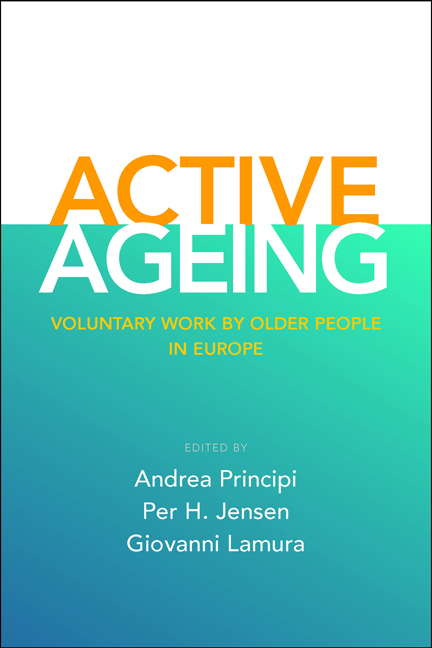Book contents
- Frontmatter
- Contents
- List of tables and figures
- Notes on the contributors
- Acknowledgements
- Foreword
- Part I Realising volunteering by older people in Europe An overarching approach
- Part II Opportunities and restrictions for older volunteers National experiences
- Part III Opportunities and restrictions for older volunteers Case studies in European voluntary organisations
- Part IV Conclusions
- Index
six - Older volunteers in England: towards greater flexibility and inclusiveness?
Published online by Cambridge University Press: 05 March 2022
- Frontmatter
- Contents
- List of tables and figures
- Notes on the contributors
- Acknowledgements
- Foreword
- Part I Realising volunteering by older people in Europe An overarching approach
- Part II Opportunities and restrictions for older volunteers National experiences
- Part III Opportunities and restrictions for older volunteers Case studies in European voluntary organisations
- Part IV Conclusions
- Index
Summary
Introduction
The UK voluntary sector comprises over 160,000 registered organisations, contributing roughly £12 billion (€14 billion) or 0.8 per cent of UK gross value added (GVA) (Clark et al, 2012). However, measuring the size of the sector in official terms (that is, according to rules followed by national accounts statisticians) fails to capture the value of the ‘unmeasured output’ contributed by volunteers. Often described as the ‘lifeblood’ of the charitable sector, about 20 million people in the UK volunteer formally at least once a year, amounting to about 40 per cent of the adult population (DCLG, 2011a). Taking just those volunteering at least once a month, this represents an economic value of £23 billion (€28 billion) if volunteers were to be replaced by paid staff (Clark et al, 2012). Although most volunteers provide unpaid help to voluntary sector organisations, volunteering also takes place in the public and private sectors. And some volunteers participate in employer-supported volunteering schemes.
The range of activities of these organisations and the motives of volunteers behind engaging in them are varied. Rochester et al (2010) observe that the ‘conceptual map’ of volunteering is broader than the type of activity that dominates public discussion, namely, volunteering in the area of social care, presumed to be driven by altruistic motives. The map also includes ‘activism’ (mutual aid, self-help or campaigning for changes in provision concerning a wide range of public policy areas) and ‘serious leisure’ (typically in areas such as the arts, culture, sport and recreation) where self-expressive or intrinsic motives prevail. Indeed, whereas by far the largest group of registered voluntary organisations is engaged in social services, followed by culture and recreation, and religion, survey data indicate that the highest levels of volunteering can be found in sports, hobbies and the arts (DCLG, 2011b), which are mainly associated with ‘serious leisure’.
The voluntary sector has grown substantially over the last decade, both in terms of financial turnover and employment, but the rate of participation in volunteering changed only slightly overall, increasing during the first half of the decade and then falling back. The growth of the sector has been particularly fuelled by the increase in public contracting-out of services to private profit-making and non-profit organisations.
- Type
- Chapter
- Information
- Active AgeingVoluntary Work by Older People in Europe, pp. 119 - 148Publisher: Bristol University PressPrint publication year: 2014

